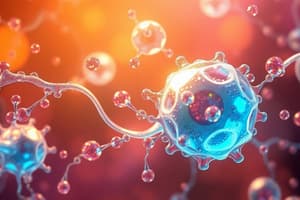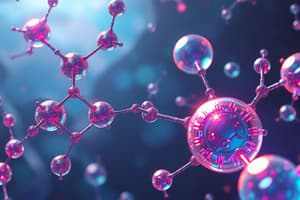Podcast
Questions and Answers
How does biochemistry contribute to advancements in biotechnology?
How does biochemistry contribute to advancements in biotechnology?
- By providing tools for manipulating cellular components for industrial applications. (correct)
- By focusing solely on theoretical aspects of cellular functions without practical applications.
- By limiting the scope of biological properties studied in cells.
- By increasing the cost of producing biological materials.
Which concept explains why mitochondria possess their own DNA and double membranes?
Which concept explains why mitochondria possess their own DNA and double membranes?
- The principle of uniformitarianism.
- The endosymbiotic hypothesis. (correct)
- The central dogma of molecular biology.
- The theory of spontaneous generation.
In eukaryotic cells, what advantages does compartmentalization provide?
In eukaryotic cells, what advantages does compartmentalization provide?
- It increases the rate of mutations.
- It reduces the overall complexity of cellular processes.
- It allows for the separation of biological functions, enhancing efficiency. (correct)
- It prevents cells from performing specialized functions.
How do starch and cellulose differ, despite both being polymers of glucose?
How do starch and cellulose differ, despite both being polymers of glucose?
What is the significance of molecules having three-dimensional shapes in biochemistry?
What is the significance of molecules having three-dimensional shapes in biochemistry?
What is the primary function of the Golgi apparatus within a cell?
What is the primary function of the Golgi apparatus within a cell?
Why are interactions between biomolecules often weak and reversible?
Why are interactions between biomolecules often weak and reversible?
Which of the following best describes the composition of the plasma membrane?
Which of the following best describes the composition of the plasma membrane?
What role do lysosomes play in cellular function?
What role do lysosomes play in cellular function?
What is the importance of studying biochemistry in medicine and health?
What is the importance of studying biochemistry in medicine and health?
Which of the following is a key function of the cytoskeleton?
Which of the following is a key function of the cytoskeleton?
Which organelle is the primary site of protein synthesis within eukaryotic cells?
Which organelle is the primary site of protein synthesis within eukaryotic cells?
How does biochemistry relate to the study of life at the molecular level?
How does biochemistry relate to the study of life at the molecular level?
What are the three main areas of study within biochemistry?
What are the three main areas of study within biochemistry?
What role does the nucleolus play within the nucleus of a eukaryotic cell?
What role does the nucleolus play within the nucleus of a eukaryotic cell?
Flashcards
What is Biochemistry?
What is Biochemistry?
The chemistry of the living cell; describes life processes at the molecular level.
Structural Biochemistry
Structural Biochemistry
Structures and 3D arrangements of molecules.
Informational Biochemistry
Informational Biochemistry
The language for storing and transmitting biological data in cells and organisms.
Bioenergetics
Bioenergetics
Signup and view all the flashcards
Six Key Elements in Biological Compounds
Six Key Elements in Biological Compounds
Signup and view all the flashcards
Four Major Classes of Biomolecules
Four Major Classes of Biomolecules
Signup and view all the flashcards
Starch and Cellulose
Starch and Cellulose
Signup and view all the flashcards
Proteins/Polypeptides
Proteins/Polypeptides
Signup and view all the flashcards
DNA
DNA
Signup and view all the flashcards
RNA
RNA
Signup and view all the flashcards
Biomacromolecules
Biomacromolecules
Signup and view all the flashcards
Nucleus
Nucleus
Signup and view all the flashcards
Endoplasmic Reticulum (ER)
Endoplasmic Reticulum (ER)
Signup and view all the flashcards
Mitochondria
Mitochondria
Signup and view all the flashcards
Endosymbiotic Hypothesis
Endosymbiotic Hypothesis
Signup and view all the flashcards
Study Notes
Introduction to Biochemistry
- Organisms consist of lifeless elements and molecules.
- Individually, these components are inanimate, but together they exhibit attributes of life.
- The living cell is the basic unit of life, capable of feeding, respiring, digesting, excreting, moving, and reproducing.
- The course will cover characteristics and biochemical activities of living cells.
Objectives of Biochemistry
- Define biochemistry
- Differentiate between prokaryotes and eukaryotes
- Identify important organelles of the cell
- Describe the functions of cell organelles
- Name the elements required by living organisms
- Discuss the importance of these elements in living organisms
- Describe the four classes of biopolymers
What Biochemistry Is
- Biochemistry is the "Chemistry of the living cell."
- It uses chemistry, biology, and physics to explain processes in living cells at the molecular level.
- Biochemistry enhances the fundamental understanding of life.
- It addresses important issues in medicine, health, and nutrition.
- Biochemistry has led to a greater molecular understanding of diseases like AIDS, cancer, diabetes, sickle cell anemia, and cystic fibrosis.
- Biochemistry advances biotechnology industries using biological cells, cell components, and biological properties in technically and industrially useful operations.
Three Areas of Study in Biochemistry
- Structural and Functional Biochemistry: Deals with the chemical structures and 3D arrangements of molecules.
- Informational Biochemistry: Focuses on the language for storing and transmitting biological data in cells and organisms.
- Bioenergetics: Studies the flow of energy in living organisms and its transfer between processes.
Tools for Biochemistry Studies
- Requires knowledge of chemical structures and reactivities of molecules in cellular reactions.
- Understanding the biological functions of cellular molecules is crucial
- Understanding how all the pieces and different pathways fit together
Simplicity and Elegance in Living Systems
- Most biological compounds are made of only six elements: C, H, O, N, P, S.
- Only 31 chemical elements occur naturally in plants and animals.
- All organisms have similar biochemical pathways and use the same genetic code.
- A limited number of molecular building blocks make up larger macromolecules.
Major Classes of Biomolecules
- Serve as building blocks for larger macromolecules:
- Carbohydrates (e.g., glucose, fructose, sucrose): mainly used as sources of cellular energy
- Lipids (fats): organic compounds not very water soluble, used as energy sources and cell membrane components
- Amino Acids: 20 total natural amino acids used as building blocks for proteins
- Nucleotides: 5 in total used as building blocks for DNA and RNA precursors
Macromolecules
- Building blocks are used to create macromolecules- polymer of several, hundreds, to sometimes millions of building blocks
- Macromolecules self-assemble into cellular structures and complexes
- They interact in specific ways to perform essential cellular functions like membranes (complexes of lipids and proteins).
- Interactions are weak and reversible.
- Molecules have three dimensions and shapes
- Starch and Cellulose: polymers of glucose molecules differing in how glucose monomers are linked
- Proteins/polypeptides: amino acid monomers linked together
- DNA (deoxyribonucleic acid): heteropolymer of monomeric nucleotides storing genetic information
- RNA (ribonucleic acid): heteropolymer of monomeric nucleotides involved in the transfer of genetic information encoded by DNA
Organisms
- There are two basic classes of organisms: prokaryotes (e.g., E. coli) and eukaryotes
- Eukaryotic cells will be the primary focus
- Similar processes occur in all cells, including prokaryotes, and much of our understanding of biochemistry comes from prokaryotic systems.
- Class includes plants, animals, fungi, protozoans, yeasts and some algae
- Large cells (10-100 (mu) m in diameter), 10X bigger than prokaryotes
- Surrounded by plasma membrane
- Composed of lipids and proteins
- Serves as chemical barrier to the outside environment
- Contain internal membranes and compartments which is a unique feature
- Compartments = organelles
- Organelles contain organized complexes of macromolecules that perform a certain biological function
- Most enzymes are compartmentalized Compartmentalization results in separation of biological function
- No cell wall in animal cells
- Plants, fungi, algae generally have a cell wall
Eukaryotic Cell Structures and Functions
- Cytoplasm/cytosol: viscous aqueous environment containing molecules, nutrients, salts, and soluble proteins (20-30% protein), major site of cellular metabolism
- Cytoskeleton: 3-dimensional matrix of protein fibers providing cell shape, movement, and guides internal organelle movement
- Nucleus: contains most DNA and RNA synthesis, storage of genetic information, enclosed by a double membrane, largest organelle in eukaryotic cells
- Endoplasmic Reticulum (ER): network of interconnected, closed, membrane-bounded vesicles attached to cell and nuclear membrane, used for manufacturing, modification, and transport of cellular materials
- Smooth ER: site of lipid synthesis
- Rough ER: site of protein synthesis via ribosomes
- Ribosomes: made up of RNA and proteins, site of protein synthesis
- Lysosomes: internal sacs bound by a single membrane, responsible for degrading obsolete cell components (internal pH ~5), degrade polymers into individual building blocks
- Golgi Apparatus: flattened vesicles of lipid/protein/sugar near smooth ER and nucleus. It is involved in protein and fat processing/trafficking to other organelles as well as distribution and shipping dept for cell materials
- Mitochondria: have double membrane, oxidative energy production occurs here as well as the "powerhouse" of the cell, form ATP, contain a circular DNA molecule like that of bacteria (own genome), believed to be descendants of bacteria engulfed by a larger cell billions of years ago = endosymbiotic hypothesis, can have over 1000 mitochondria per cell
Studying That Suits You
Use AI to generate personalized quizzes and flashcards to suit your learning preferences.




